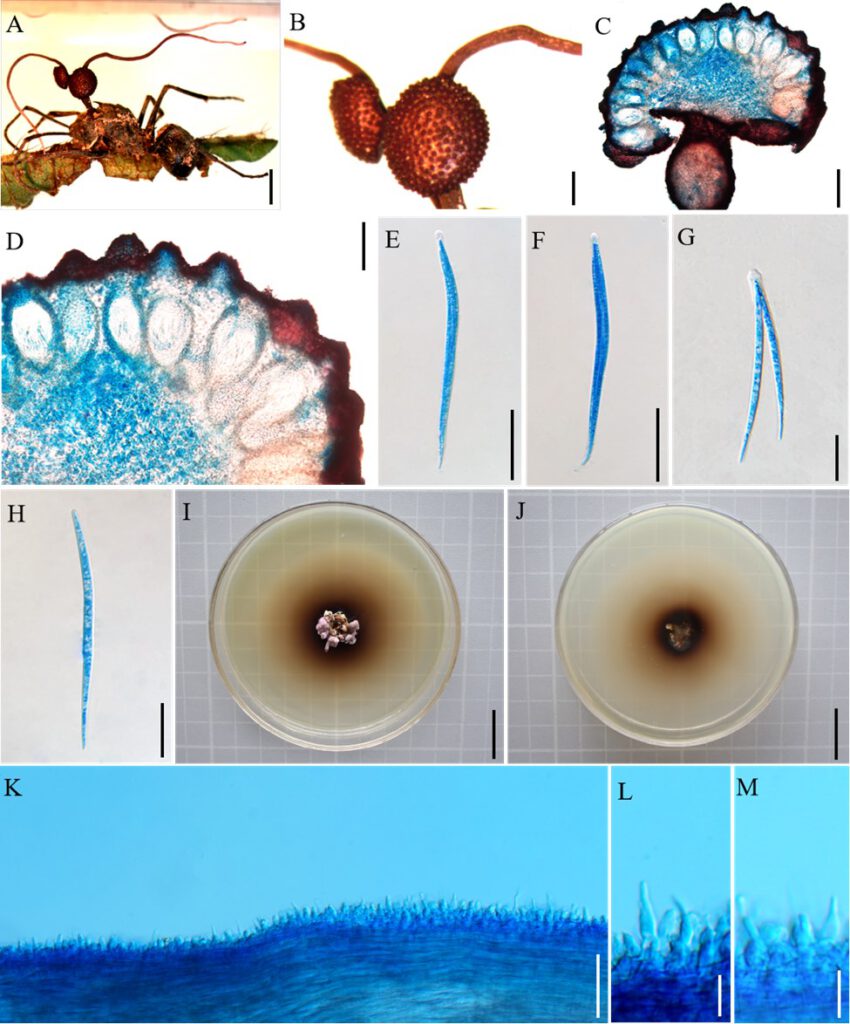Ophiocordyceps bifertilis H. Yu & D.X. Tang.
MycoBank number: MB; Index Fungorum number: IF; Facesoffungi number: FoF 11707;
Description
Subtropical monsoon evergreen broad-leaf forest. Polyrhachis sp. infected and biting the main vein of a leaf, always at lower heights, ranging from 0.5 m to 1.5 m. Sexual state: External mycelium was scarcely produced from the sutures and joints, producing one to multiple stromata at the head of the ant, few branching, curved, cylindrical, clavate, dark brown. Ascomata of lateral cushions produced from the stroma, only two ascomata were observed, disc-shaped or hemispherical, brown, averaging 3–3 × 2–3 mm. Perithecia flask-shaped, immersed to partially erumpent, with short, exposed neck or rounded ostiole, 149–236 × 91–134 μm. Asci cylindrical, hyaline, 8-spored, 117–211 × 5–9 μm. Ascus caps were hemispherical, prominent, 3–5 µm high, 5–6 µm wide. Ascospore fusiform, hyaline, septate, round to tapered at apex, 70–97 × 2–4 µm. Asexual state: Colonies on PDA grows slowly, 19–20 mm diameter in 120 days at 25 C, light purple and light brown, hard, with protuberant mycelial at the edge, reverse light brown to dark brown, pigment light brown to dark brown. Hirsutella type-A was present on the stroma. Phialides lageniform, smooth, swollen base, tapering abruptly a neck, short, 7–29 × 2–4 µm. Conidia were not observed.
Material examined: CHINA, biting on leaves of tree seedlings, 18 August 2020, H. Yu (YHH 20160, neotype).
Distribution: Puer City, Yunnan Province, China
Sequence data: LSU: ON555923 (LROR/LR5); SSU: ON555843 (NS1/NS4); EF1a: ON567763 (983F/2218R); RPB1: ON568143 (RPB1/RPB1Cr_oph); RPB2: ON568135 (fRPB2-5F/fRPB2-7cR)
Notes: Phylogenetic analyses revealed that the O. bifertilis formed a sister lineage with O. satoi and O. naomipierceae, it clustered in the O. unilateralis core clade of Hirsutella, with statistical support from BI posterior probabilities (PP = 82%) and ML bootstrap proportions (BP = 82%), formed a separate clade with O. satoi and O. naomipierceae (Figure 1). O. bifertilis was similar to O. satoi and O. naomipierceae in the behavior of the host Polyrhachis infected and biting a leaf. In addition, it was also similar to O. satoi in stroma clavate, perithecia flask-shaped, immersed, exposed ostiole, asci cylindrical, ascospore round to tapered at apex, Hirsutella type-A present on the stroma, phialides lageniform. However, it differs from O. satoi by stroma branching, only two ascomata, fertile part disc-shaped or hemispherical, ascospores fusiform, and the size of perithecia, ascoma, asci, ascospore. Moreover, the size of phialides also differed from O. satoi and O. naomipierceae (Table 2)

Fig. 3. Ophiocordyceps bifertilis (YHH 20160). A: Polyrhachis sp. infected and biting the main vein of a leaf. B: Two ascomata plates attached to stromata. C–D: Cross-section of the ascoma showing the perithecial arrangement. E–F: Asci. G-H: Ascospores. I-J: Colonies on PDA medium. K-L: Phialides. Scale bars: A = 4000 µm; B = 1000 µm; C = 200 µm; D = 100 µm; E-F = 50 µm; G-H = 20 µm; I-J = 2 cm; K-M = 10 µm.
